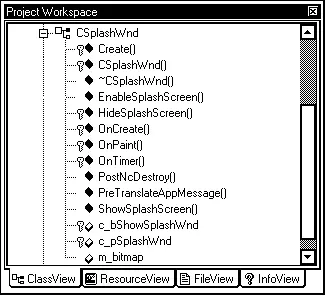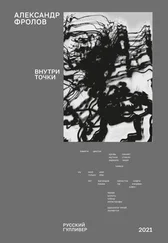
Рис. 2.4. Окно Project Workspace, класс CSplashWnd
Определение класса CSplashWnd находится в файле Splash.h. Мы привели его полностью в листинге 2.1.
Класс CSplashWnd создан на основе базового класса CWnd. Он включает в себя ряд методов и несколько элементов данных. Класс CSplashWnd может обрабатывать сообщения, поэтому для него в файле Splash.h определена макрокоманда DECLARE_MESSAGE_MAP, а в файле реализации — Splash.cpp — таблица сообщений класса.
Листинг2.1. Файл Splash.h
// CG: This file was added by the Splash Screen component.
#ifndef _SPLASH_SCRN_
#define _SPLASH_SCRN_
// Splash.h : header file
//
//////////////////////////////////////////////////////////////
// Splash Screen class
class CSplashWnd : public CWnd {
// Construction
protected:
CSplashWnd();
// Attributes:
public:
CBitmap m_bitmap;
// Operations
public:
static void EnableSplashScreen(BOOL bEnable = TRUE);
static void ShowSplashScreen(CWnd* pParentWnd = NULL);
static void PreTranslateAppMessage(MSG* pMsg);
// Overrides
// ClassWizard generated virtual function overrides
//{{AFX_VIRTUAL(CSplashWnd)
//}}AFX_VIRTUAL
// Implementation
public:
~CSplashWnd();
virtual void PostNcDestroy();
protected:
BOOL Create(CWnd* pParentWnd = NULL);
void HideSplashScreen();
static BOOL c_bShowSplashWnd;
static CSplashWnd* c_pSplashWnd;
// Generated message map functions
protected:
//{{AFX_MSG(CSplashWnd)
afx_msg int OnCreate(LPCREATESTRUCT lpCreateStruct);
afx_msg void OnPaint();
afx_msg void OnTimer(UINT nIDEvent);
//}}AFX_MSG
DECLARE_MESSAGE_MAP()
};
#endif
Методы класса CSplashWnd определены в файле реализации – Splash.cpp. Этот файл также добавляется к проекту Multi. Мы привели полный исходный текст этого файла в листинге 2.2.
Листинг2.2. Файл Splash.cpp
Листинг 2.2. ФайлSplash.cpp
// CG: Файл Splash.cpp добавляется в проект во время вставки
// компонента Splash Screen и содержит реализацию класса
// CSplashWnd
#include "stdafx.h"
#include "resource.h"
#include "Splash.h"
#ifdef _DEBUG
#define new DEBUG_NEW
#undef THIS_FILE
static char BASED_CODE THIS_FILE[] = __FILE__;
#endif
//////////////////////////////////////////////////////////////
// Splash Screen class
BOOL CSplashWnd::c_bShowSplashWnd;
CSplashWnd* CSplashWnd::c_pSplashWnd;
CSplashWnd::CSplashWnd() {}
CSplashWnd::~CSplashWnd() {
// Clear the static window pointer.
ASSERT(c_pSplashWnd == this);
c_pSplashWnd = NULL;
}
BEGIN_MESSAGE_MAP(CSplashWnd, CWnd)
//{{AFX_MSG_MAP(CSplashWnd)
ON_WM_CREATE()
ON_WM_PAINT()
ON_WM_TIMER()
//}}AFX_MSG_MAP
END_MESSAGE_MAP()
void CSplashWnd::EnableSplashScreen(BOOL bEnable /*= TRUE*/) {
c_bShowSplashWnd = bEnable;
}
void CSplashWnd::ShowSplashScreen(CWnd* pParentWnd /*= NULL*/) {
if (!c_bShowSplashWnd || c_pSplashWnd != NULL) return;
// Allocate a new splash screen, and create the window.
c_pSplashWnd = new CSplashWnd;
if (!c_pSplashWnd->Create(pParentWnd)) delete c_pSplashWnd;
else c_pSplashWnd->UpdateWindow();
}
BOOL CSplashWnd::PreTranslateAppMessage(MSG* pMsg){
if (c_pSplashWnd == NULL) return FALSE;
// If we get a keyboard or mouse message, hide the splash
// screen.
if (pMsg->message == WM_KEYDOWN || pMsg->message == WM_SYSKEYDOWN || pMsg->message == WM_LBUTTONDOWN || pMsg->message == WM_RBUTTONDOWN || pMsg->message == WM_MBUTTONDOWN || pMsg->message == WM_NCLBUTTONDOWN || pMsg->message == WM_NCRBUTTONDOWN || pMsg->message == WM_NCMBUTTONDOWN) {
c_pSplashWnd->HideSplashScreen();
return TRUE; // message handled here
}
return FALSE; // message not handled
}
BOOL CSplashWnd::Create(CWnd* pParentWnd /*= NULL*/) {
if (!m_bitmap.LoadBitmap(IDB_SPLASH)) return FALSE;
BITMAP bm;
m_bitmap.GetBitmap(&bm);
return CreateEx(0, AfxRegisterWndClass(0, AfxGetApp()->LoadStandardCursor(IDC_ARROW)), NULL, WS_POPUP | WS_VISIBLE, 0, 0, bm.bmWidth, bm.bmHeight, pParentWnd->GetSafeHwnd(), NULL);
}
void CSplashWnd::HideSplashScreen(){
// Destroy the window, and update the mainframe.
DestroyWindow();
AfxGetMainWnd()->UpdateWindow();
}
void CSplashWnd::PostNcDestroy(){
// Free the C++ class.
delete this;
}
int CSplashWnd::OnCreate(LPCREATESTRUCT lpCreateStruct) {
if (CWnd::OnCreate(lpCreateStruct) == -1) return -1;
// Center the window.
CenterWindow();
// Set a timer to destroy the splash screen.
SetTimer(1, 750, NULL);
return 0;
}
void CSplashWnd::OnPaint(){
CPaintDC dc(this);
CDC dcImage;
if (!dcImage.CreateCompatibleDC(&dc)) return;
BITMAP bm;
m_bitmap.GetBitmap(&bm);
// Paint the image.
CBitmap* pOldBitmap = dcImage.SelectObject(&m_bitmap);
dc.BitBlt(0, 0, bm.bmWidth, bm.bmHeight, &dcImage, 0, 0, SRCCOPY);
dcImage.SelectObject(pOldBitmap);
}
void CSplashWnd::OnTimer(UINT nIDEvent) {
// Destroy the splash screen window.
HideSplashScreen();
}
Вы всегда можете получить файл Splash.cpp следуя инструкциям в начале раздела “Заставка для приложения”. Теперь опишем отдельные методы класса.
Читать дальше








